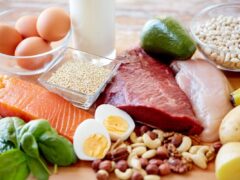Normal, healthy kidneys remove waste from the blood. If you have chronic kidney disease, your kidneys are not working as well as they should. They have trouble removing the waste. This causes the waste in the blood to build up. This can lead to additional health problems and puts extra stress on your kidneys.
Eating the right foods is an important part of managing chronic kidney disease. A chronic kidney disease diet helps protect your kidneys and slow the progression of CKD. By understanding what to eat—and what to limit—you can take control of your health and feel your best.
Key guidelines for a chronic kidney disease diet
Some of the waste that can build up in your blood comes from nutrients in the food you eat. Your body needs most of these nutrients for its day-to-day functions. When your kidneys aren’t working well, certain nutrients can become a problem.
Nutrients that can become a problem
Phosphorous. Phosphorous is a mineral that keeps bones healthy and strong. But, even in early stages of chronic kidney disease, the level of phosphorous in your blood can become too high. A high level of phosphorous can cause itchy skin. It can also cause your bones to lose calcium. If this happens, your bones will get weaker and more brittle. You also have a greater risk of developing osteoporosis.
Foods high in phosphorous include:
- Dairy products, such as milk, cheese, yogurt, and ice cream
- Dried beans and peas, such as kidney beans, split peas, and lentils
- Nuts and peanut butter
- Drinks like beer, cola, and hot cocoa
If your phosphorous level is too high even after you change your diet, your doctor may prescribe medicine to lower it.
Calcium. You need calcium to build strong bones. Unfortunately, foods that contain calcium often also contain phosphorous. If you have chronic kidney disease, you may need to take calcium supplements that are phosphorous-free. Your doctor may also prescribe a special type of vitamin D. This will help your body absorb calcium.
Protein. You need protein to build and maintain healthy muscles, bones, skin, and blood. Protein also helps your body fight infection and heal wounds.
Foods that are high in protein include:
- Meats, including beef, pork, chicken, and turkey
- Dairy products, including cheese, milk, and yogurt
- Eggs
- Beans
- Nuts
When protein breaks down, it turns into waste. Kidneys damaged by disease can’t stop this waste from building up in the blood. Many people with early chronic kidney disease should eat a low-protein diet. Talk to your doctor about whether you should reduce your protein.
Potassium. Potassium is a mineral that helps your brain, nerves, muscles, and heart work properly. It is found in foods such as bananas, potatoes, tomatoes, avocados, and melons. Too much or too little potassium can cause serious problems. Your body needs balanced potassium levels. Your doctor will determine whether you need to change the amount of potassium in your diet. This will depend on the stage of your kidney disease and whether you are taking medicine to help lower your potassium level.
Sodium. Too much sodium (salt), may cause you to retain fluid. This extra fluid can raise your blood pressure. This puts stress on your heart and kidneys.
Check food labels for sodium. Packaged and processed foods are high in sodium. You may know that foods such as soy sauce, processed meats, crackers, and potato chips contain a lot of sodium. But you may not realize how much sodium is in foods like bread, canned vegetables, soups, and cheese. Look for sodium-free or low-sodium foods.
Don’t add salt to your food. Try different seasonings, such as lemon juice, hot pepper sauce, and salt-free spices. Avoid salt substitutes. They often contain high levels of potassium.
Fluids. If you have trouble getting rid of fluid from your body, you need to be careful about how much you drink. Too much fluid can put additional strain on your kidneys.
Calories. You need to take in the right amount of calories to maintain a healthy weight and support your body’s functions. This can be challenging for people who have chronic kidney disease. Limiting the amount of protein, dairy, salt, and certain nutrients in your diet reduces your food choices. Foods you used to eat may no longer be healthy options for you. Also, your appetite may be affected by chronic kidney disease. Even if it’s fine to eat certain foods you used to enjoy, they may not have the same appeal.
Planning meals on a chronic kidney disease diet
Your family doctor can help you make a diet plan that supports your kidney health. This is important because your diet may need to change as your kidney disease and the medicines you take change. Your doctor may recommend that you work with a registered dietitian to be sure you get the right amount of calories each day.
To increase your calorie intake, your doctor or dietitian may suggest adding simple carbohydrates or foods with high carbohydrate concentrations. Fats can be a good source of calories. But saturated fats increase your risk of cardiovascular disease. Avoid foods such as fatty cuts of meat, butter, dairy products, baked goods, and fried foods. These often contain saturated fats. Instead, choose monounsaturated or polyunsaturated fats, such as olive oil or canola oil. These good fats are better for your cardiovascular health.
How to monitor the impact of your diet on kidney health
You can track how your diet is affecting your kidneys. Several tests are available to help. The tests can tell you whether your diet is reducing the stress on your kidneys.
To measure how well your kidneys are filtering waste from your blood, your doctor may estimate your glomerular filtration rate (eGFR). This test evaluates the amount of creatinine (a type of waste) in your blood. A declining eGFR indicates that your kidney function is getting worse. Other changes in your diet or medicines may be necessary.
A simple dipstick urine test can reveal whether your kidneys are losing function. This test measures albumin and other protein wastes that build up when the kidneys aren’t working well.
The serum albumin test is a blood test that shows whether you are taking in enough protein and calories. If you’re not, you may be at risk of infections. You may not feel well overall.
The normalized protein nitrogen appearance (nPNA) test measures your protein balance to determine whether you are getting enough protein. This test involves a blood and urine sample.
The blood urea nitrogen (BUN) test measures the level of urea in the blood. Urea is one of the wastes left over when your body breaks down protein. A high BUN level may indicate that you are taking in too much protein.
Your doctor may also do a physical exam. He or she may ask some questions to identify any problems with your diet. They will want to know about any changes in your weight or your body fat and muscle. Your doctor may also ask about the amount of food you eat, as well as your activity and energy levels.
Dietary considerations for people on dialysis
If you are on dialysis, you still need to watch what you eat. Dialysis can filter your blood very effectively. But it can’t remove all the waste your body makes when it processes nutrients. You are at increased risk of waste levels rising between your dialysis sessions.
Questions to ask your doctor
- Why do I need to make changes in my diet?
- What changes do I need to make to my diet?
- Do I need to see a dietician?
- Will I need to reduce the amount of protein I eat?
- Will my diet change when I begin dialysis?
ADVERTISEMENT
ADVERTISEMENT




